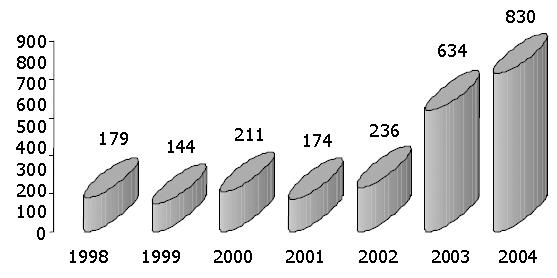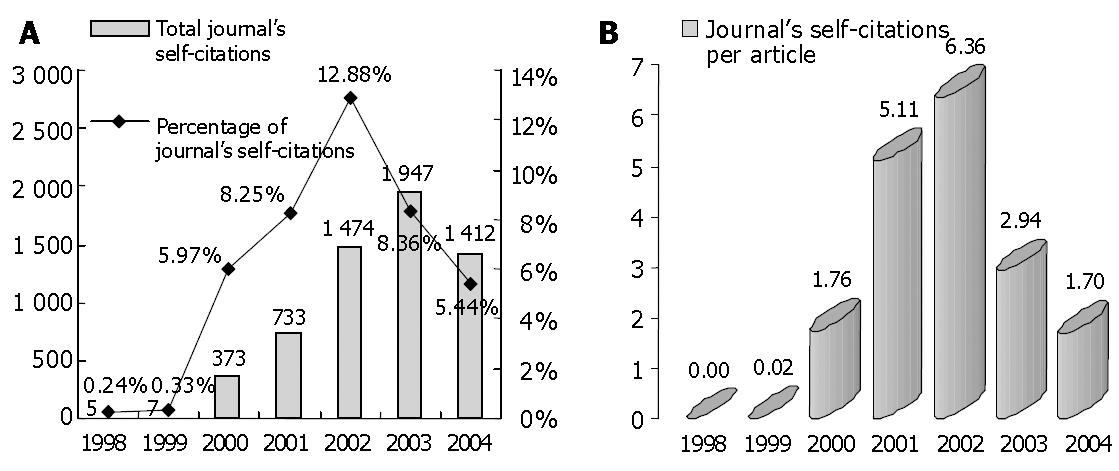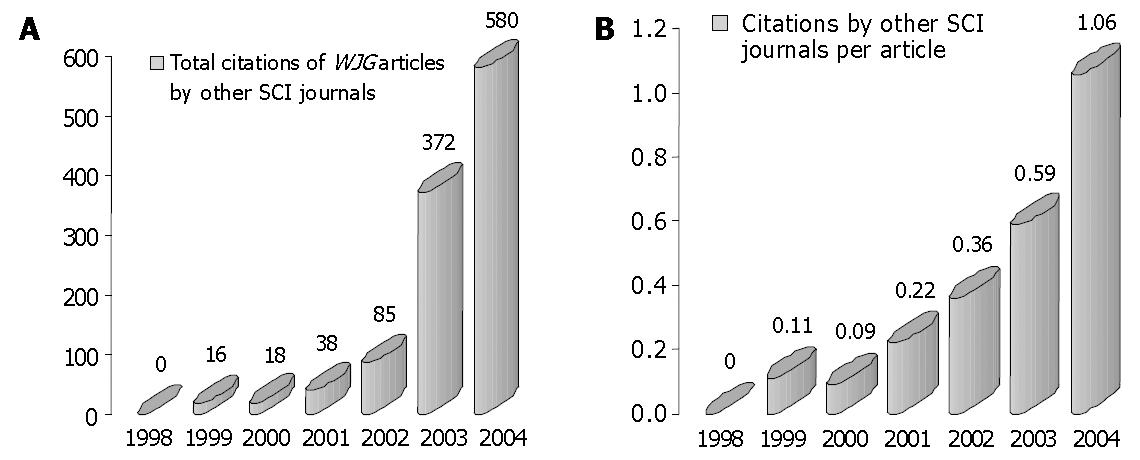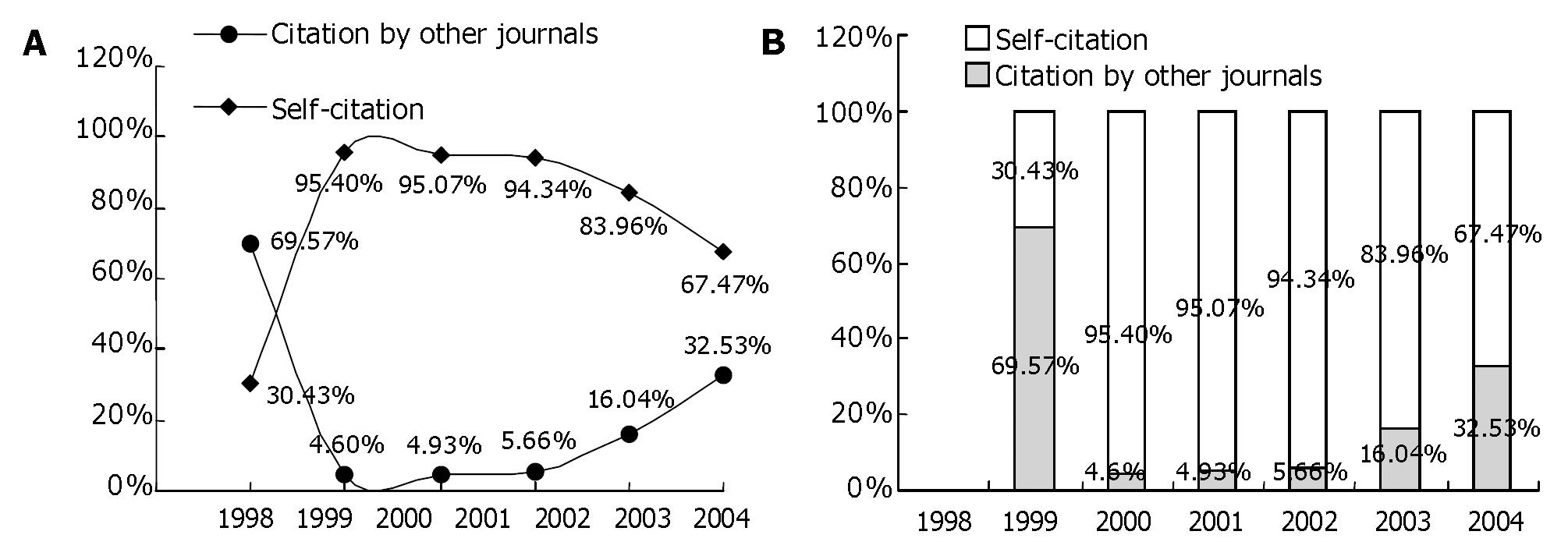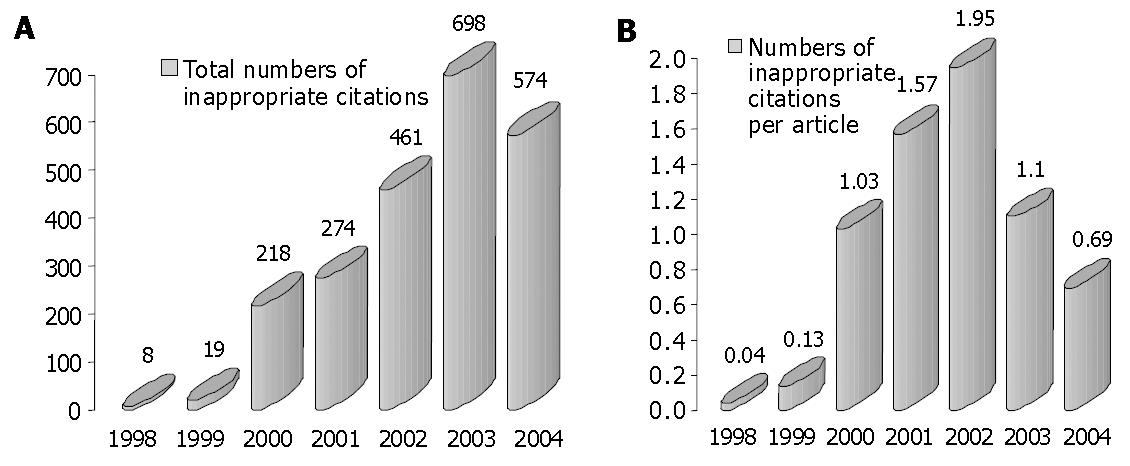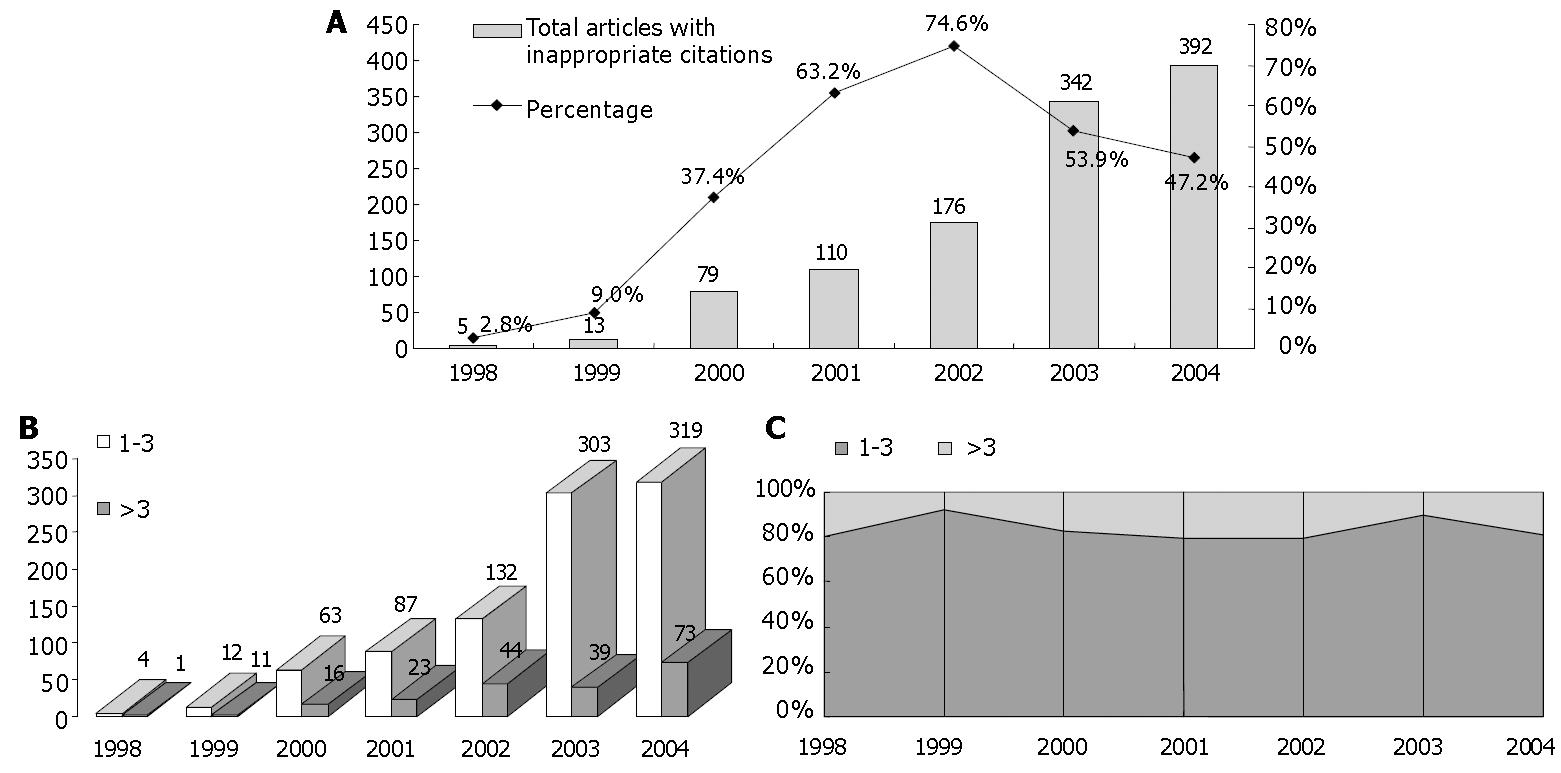Published online Jan 7, 2005. doi: 10.3748/wjg.v11.i1.1
Revised: September 14, 2004
Accepted: September 17, 2004
Published online: January 7, 2005
AIM: To determine the citation status in 2004 and the citation trend of WJG by analyzing all articles cited by WJG and all WJG articles cited by SCI journals during 1998-2004.
METHODS: The total number of published articles and reference citations in WJG, authors’ self-citations, WJG’ self-citations, citations of WJG articles by SCI journals and inappropriate citations in WJG during 1998-2004 were statistically analyzed. Data on self-citations of the articles published between 1998 and August 2004 (Issues 1-16) were from ISI SCI-E, and data on self-citations of articles published after August 2004 (Issues 17-24) were from the WJG Editorial Office. Data on citations of WJG articles by other journals between 1998 and August 2004 were from ISI SCI-E.
RESULTS: Annual number of published articles: WJG published 179, 144, 211, 174, 236, 634 and 830 articles, respectively, in 1998, 1999, 2000, 2001, 2002, 2003 and 2004. The number in 2004 increased by 594, compared to that in 2002, giving an increased rate of 251.7%. Annual references cited by WJG were 2 123, 2 125, 6 244, 8 883, 11 442, 23 218 and 25 971, respectively, in 1998-2004. The average number was 31.3 per WJG article in 2004, which was less than that (48.5) in 2002, giving a reduction rate of 35.5%. Authors of WJG cited 125, 126, 343, 210, 354, 310 and 470 of their own published articles, respectively, in 1998-2004. The average number of authors’ self-citations was 0.57 per WJG article in 2004, which was decreased by 0.93 or 62.0%, compared with that in 2002. Annual numbers of journal’ self-citations: Authors of WJG articles cited 5, 7, 373, 733, 1474, 1947 and 1412 of WJG articles, respectively, in 1998-2004. The average number of journal’ self-citations was 1.70 per WJG article in 2004, which decreased by 4.55 or 72.8%. No WJG article was cited in 1998 by other SCI journals. However, the number of citations steadily increased afterwards, with 16, 18, 39, 85, 372 and 580, respectively, in 1999-2004. The average number of citations by other SCI journals was 0.11, 0.09, 0.22, 0.36, 0.59 and 1.06 per WJG article, respectively, 1999-2004 (January-August). There was an increase by 582%, when comparing the citation numbers between 2004 and 2002. Annual WJG self-citation rates and citation rates of WJG articles by other SCI journals: WJG self-citation rates were 30.43%, 95.40%, 95.07%, 94.55%, 83.96% and 67.47%, respectively, in 1999-2004 (January-August). Compared with 2002, the self-citation rate in 2004 decreased by 26.87%. The citation rates of WJG articles by other SCI journals were 69.57%, 4.60%, 4.93%, 5.45%, 16.04%, and 32.53%, respectively, in 1999-2004 (January-August). Compared with 2002, the citation rate in 2004 decreased by 26.87%. There were 8, 19, 218, 274, 461, 698 and 574 inappropriate citations, respectively, in 1998-2004. The average inappropriate citation in 2004 was 0.69 per article, which represents a decrease of 1.26, compared with that in 2002. Inappropriate citations were mostly those with the differences between the two sides of the hyphens of 5-9, and the proportions of inappropriate citations within the three subsections of the differences between the two sides of the hyphens (5-9, 10-19, and >=20) were approximately 7:2:1. In addition, inappropriate citations mostly occurred with frequencies of 1-3 in the articles, and the proportion of inappropriate citations within the two frequency subsections (1-3 and >3) have been approximately 4:1 since 1999.
CONCLUSIONS: In 2004, the average number of reference citations, authors’ self-citations and journal’ self-citations were 31.3, 0.57 and 1.70 per article, respectively, which represents a decrease in the numbers by 35.5%. 62.0%, and 72.8% respectively compared to the corresponding numbers in 2002. WJG self-citation rate was 67.47% in 2004 (January-August), which was a decrease by 26.87%, compared with 2002. The citation rate of WJG articles by other SCI journals was 32.53% in 2004 (January-August), an increase of 26.87%, compared to 2002. There were 574 inappropriate citations in 2004, with an average of 0.69 per article, which represents a decrease of 1.26, compared with that in 2002. These figures demonstrate that the overall citation status of WJG is improving.
-
Citation: Ma LS, Pan BR, Li WZ, Guo SY. Improved citation status of
World Journal Gastroenterology in 2004: Analysis of all reference citations byWJG and citations ofWJG articles by other SCI journals during 1998-2004. World J Gastroenterol 2005; 11(1): 1-6 - URL: https://www.wjgnet.com/1007-9327/full/v11/i1/1.htm
- DOI: https://dx.doi.org/10.3748/wjg.v11.i1.1
The English version of the World Journal of Gastroenterology (WJG) has been formally published for six years. Over the past six years, WJG has developed rapidly both in contents and quality, with the impact factor steadily increased. However, there were also some areas that need improvement in the future. For example, self-citation is one of the major concerns. The aim of this study was to identify the citation trend of WJG by analyzing all articles cited by WJG and all WJG articles cited by SCI journals.
All references cited by WJG and all WJG articles cited by SCI journals between 1998 and 2004 (January-August) were included in the analyses. The number of articles published and references cited in WJG, authors’ self-citations, journal’ self-citations, citations and numbers of WJG articles by other SCI journals and inappropriate citations in WJG during 1998-2004 were determined. Data on self-citation of articles published between 1998 and August 2004 (Issues 1-16) was from ISI SCI-E, and data on self-citation of articles published after August 2004 (Issues 17-24) was from the WJG Editorial Office. Data on citations of WJG articles between 1998 and August 2004 by other SCI journals was from ISI SCI-E.
The crude data on the number of articles published and references cited in WJG, authors’ self-citations, journal’ self-citations, citations and numbers of WJG articles by other SCI journals and inappropriate citations in WJG during 1998-2004 are summarized in Table 1.
| Year | Issue | Published articles | Reference citations | Reference citations per article | Authors’ self-citations | Authors’ citations per article | Journal’s self-citations | Journal’s self-citations per article | Citations by other SCI journals | Citations by other SCI journal sper article | Inappropriate citations | Inappropriate citations per article |
| 1998 | Bimonthly | 179 | 2123 | 11.9 | 125 | 0.70 | 5 | 0.03 | 0 | 0.00 | 8 | 0.04 |
| 1999 | Bimonthly | 144 | 2125 | 14.8 | 126 | 0.86 | 7 | 0.05 | 16 | 0.11 | 19 | 0.13 |
| 2000 | Bimonthly | 211 | 6244 | 29.6 | 343 | 1.63 | 373 | 1.77 | 18 | 0.09 | 218 | 1.03 |
| 2001 | Bimonthly | 174 | 8883 | 51.1 | 210 | 1.21 | 733 | 4.21 | 38 | 0.22 | 274 | 1.57 |
| 2002 | Bimonthly | 236 | 11442 | 48.5 | 354 | 1.50 | 1474 | 6.25 | 85 | 0.36 | 461 | 1.95 |
| 2003 | Monthly | 634 | 23218 | 36.6 | 310 | 0.49 | 1947 | 3.07 | 372 | 0.59 | 698 | 1.10 |
| 2004 | Semimonthly | 830 | 25971 | 31.3 | 470 | 0.57 | 1412 | 1.70 | 5801 | 1.061 | 574 | 0.69 |
WJG was published bimonthly between 1998 and 2002, and the number of published articles was relatively stable, with a slightly increasing trend. The journal was published monthly in 2003, and then semimonthly in 2004 to promote the development of gastroenterology and speed up the communication of research outcomes. WJG published 179, 144, 211, 174, 236, 634 and 830 articles, respectively, in 1998, 1999, 2000, 2001, 2002, 2003 and 2004. The number in 2004 increased by 594, compared to that in 2002, giving an increase rate of 251.7% (Figure 1).
Reference citations consistently increased during 1998-2004. WJG cited 2 123, 2 125, 6 244, 8 883, 11 442, 23 218 and 25 971 references respectively in 1998, 1999, 2000, 2001, 2002, 2003 and 2004 (Figure 2A). The reference citations per article were 11.9, 14.8, 29.6, 51.1, 48.5, 36.6 and 31.3, respectively, in 1998, 1999, 2000, 2001, 2002, 2003 and 2004 (Figure 2B). The number of reference citations per article in 2004 was 17.2% less than that in 2002, giving a reduction rate of 35.5%.
Authors’ self-citations are defined as the number that authors of WJG cite their own previously published articles in their WJG articles. Authors of WJG cited 125, 126, 343, 210, 354, 310 and 470 of their own published articles, respectively, in 1998, 1999, 2000, 2001, 2002, 2003 and 2004 (Figure 3A). The authors’ self-citations per article were 0.70, 0.86, 1.63, 1.21, 1.50, 0.49 and 0.57, respectively in 1998, 1999, 2000, 2001, 2002, 2003 and 2004 (Figure 3B). The authors’ self-citations per article in 2004 were decreased by 0.93 or 62.0%, compared with that in 2002.
Annual journal’ self-citations are defined as the number that authors of WJG cite articles previously published in WJG in their WJG articles. Authors of WJG articles cited 5, 7, 373, 733, 1474, 1947 and 1412 of WJG articles respectively in 1998, 1999, 2000, 2001, 2002, 2003 and 2004 (Figure 4A). The journal’ self-citations per article were 0.03, 0.05, 1.77, 4.21, 6.25, 3.07 and 1.70 respectively in 1998, 1999, 2000, 2001, 2002, 2003 and 2004 (Figure 4B). The journal’ self-citations per article in 2004 decreased by 4.55 or 72.8% compared with that in 2002.
Citations of WJG articles by other SCI journals are defined as the number that articles published in WJG have been cited by SCI journals. No WJG article was cited in 1998 by other SCI journals. However, the number of citations steadily increased afterwards, with 16, 18, 39, 85, 372 and 580 respectively in 1999, 2000, 2001, 2002, 2003 and 2004 (Figure 5A). The number of citations by other SCI journals per article was 0.11, 0.09, 0.22, 0.36, 0.59 and 1.06 respectively in 1999, 2000, 2001, 2002, 2003 and 2004 (January-August) (Figure 5B). There was an increase of 582% in the number of citations between 2002 and 2004.
Self-citation rate is defined by SCI as the quotient obtained by dividing the citation number of a journal’ articles cited by that journal by the total citation number of the journal’ articles cited by all journals, i.e.,
Self-citation rate = Citation number of a Journal’ articles by that journal/ Total citation number of a journal’ articles by all journals
Citation rate by other journals is defined by SCI as the quotient obtained by dividing the citation number of a journal’ articles cited by that journal by the total citation number of the journal’ articles cited by all journals, i.e.,
Citation rate by other journals = Citation number of a Journal’ articles by other journals/ Total citation number of a journal’ articles by all journals
Annual WJG self-citation rate and citation rate of WJG articles by other SCI journals: WJG self-citation rates were 30.43%, 95.40%, 95.07%, 94.55%, 83.96% and 67.47% respectively in 1999, 2000, 2001, 2002, 2003 and 2004 (January-August)(Figure 6). Compared to 2002, the self-citation rate in 2004 decreased by 26.87%. The citation rates of WJG articles by other SCI journals were 69.57%, 4.60, 4.93%, 5.45%, 16.04%, and 32.53% respectively in 1999, 2000, 2001, 2002, 2003 and 2004 (January-August). Compared with 2002, the citation rate in 2004 increased by 27.08%.
Inappropriate citations are defined as those that are connected by a hyphen with a difference between the two sides of the hyphen being 5 or more than 5. For example, [1-6], [2-14] and 4-10 in [1, 3, 4-10, 22] are inappropriate citations. There were 8, 19, 218, 274, 461, 698 and 574 inappropriate citations, respectively, in 1998, 1999, 2000, 2001, 2002, 2003 and 2004 (Figure 7A). The inappropriate citation per article in 2004 was 0.69, which represents a decrease of 1.26, compared to that (1.95) in 2002 (Figure 7B).
Subsection analysis of the differences between the two sides of the hyphens Subsection analysis of the differences between the two sides of the hyphens was carried out to reveal the extent of inappropriate citations. Three subsections with the differences of 5-9, 10-19 and >20 were defined in the analysis. It was observed that most inappropriate citations were located in the first subsection (Figure 8A). Since 1999, the proportions of inappropriate citations within the three subsections has been approximately 7:2:1 (Figure 8B).
Subsection analysis of the frequency Subsection analysis of the frequency was carried out to reveal the frequency of inappropriate citations in the articles. Two subsections with the inappropriate citations of 1-3 and >3 per article were defined in the analysis. There were 5, 13, 79, 111,176, 342 and 392 articles with inappropriate citations, respectively, in 1998, 1999, 2000, 2001, 2002, 2003 and 2004 (Figure 9A). It was observed that most inappropriate citations were located in the first subsection (Figure 9B). Since 1999, the proportions of inappropriate citations within the two subsections have been approximately 4:1 (Figure 9C).
Annual published articles: WJG published 179, 144, 211, 174, 236, 634 and 830 articles, respectively, in 1998, 1999, 2000, 2001, 2002, 2003 and 2004. The number in 2004 increased by 594, compared with that in 2002, giving a rate of increase 251.7%.
Annual references cited by WJG: WJG cited 2 123, 2 125, 6 244, 8 883, 11 442, 23 218 and 25 971 references, respectively, in 1998, 1999, 2000, 2001, 2002, 2003 and 2004. The number was 31.3 per article in 2004, which was less than that (48.5) in 2002, giving a reduction rate of 35.5%.
Annual number of authors’ self-citations: Authors of WJG cited 125, 126, 343, 210, 354, 310 and 470 of their own published articles, respectively, in 1998, 1999, 2000, 2001, 2002, 2003 and 2004. The number of authors’ self-citations per article was 0.57 in 2004, which was a decrease of 0.93 or 62.0%, compared with that in 2002.
Annual number of journal’ self-citation: Authors of WJG articles cited 5, 7, 373, 733, 1474, 1947 and 1412 of WJG articles, respectively, in 1998, 1999, 2000, 2001, 2002, 2003 and 2004. The number of journal’ self-citations per article was 1.70 in 2004, a decrease of 4.55 or 72.8%.
Annual citations of WJG articles by other SCI journals: No WJG article was cited in 1998 by other SCI journals. However, the number of citations steadily increased afterwards, with 16, 18, 39, 85, 372 and 580, respectively, in 1999, 2000, 2001, 2002, 2003 and 2004. The number of citations by other SCI journals per article was 0.11, 0.09, 0.22, 0.36, 0.59 and 1.06 per WJG article, respectively, in 1999, 2000, 2001, 2002, 2003 and 2004 (January-August). There was an increase of 582%, when comparing the citation numbers between 2002 and 2004.
Annual WJG self-citation rates and citation rates of WJG articles by other SCI journals: WJG self-citation rates were 30.43%, 95.40%, 95.07%, 94.55%, 83.96% and 67.47% respectively in 1999, 2000, 2001, 2002, 2003 and 2004 (January-August). Compared to 2002, the self-citation rate in 2004 decreased by 26.87%. The citation rates of WJG articles by other SCI journals were 69.57%, 4.60%, 4.93%, 5.45%, 16.04%, and 32.53% respectively in 1999, 2000, 2001, 2002, 2003 and 2004 (January-August). Compared to 2002, the citation rate in 2004 increased by 26.87%.
Annual inappropriate citations: There were 8, 19, 218, 274, 461, 698 and 574 inappropriate citations, respectively, in 1998, 1999, 2000, 2001, 2002, 2003 and 2004. The inappropriate citation per article in 2004 was 0.69, which represents a decrease of 1.26, compared to that in 2002. Inappropriate citations were mostly those with the differences between the two sides of the hyphens of 5-9, and the proportion of inappropriate citations within the three subsections of the differences between the two sides of the hyphens (5-9, 10-19, and >=20) was approximately 7:2:1. In addition, inappropriate citations mostly occurred with frequencies of 1-3 in the articles, and the proportions of inappropriate citations within the two frequency subsections (1-3 and >3) have been approximately 4:1 since 1999.
In 2004, the numbers of reference citations per article, authors’ self-citations per article and journal’ self-citations per article were 31.3, 0.57 and 1.70, respectively, which represent a decrease of 35.5%. 62.0%, and 72.8% in the numbers, compared to the corresponding numbers in 2002. WJG self-citation rate was 67.47% in 2004 (January-August), a decrease of 26.87% compared to that in 2002. The citation rate of WJG articles by other SCI journals was 32.53% in 2004 (January-August), which was an increase of 26.87% compared to that in 2002. The inappropriate citations (0.69 per article) in 2004 represented a decrease of 1.26, compared with that in 2002. These figures demonstrate that the overall citation status of WJG is improving.
Edited by Xia HHX









